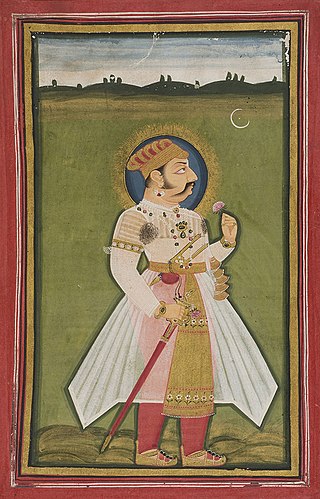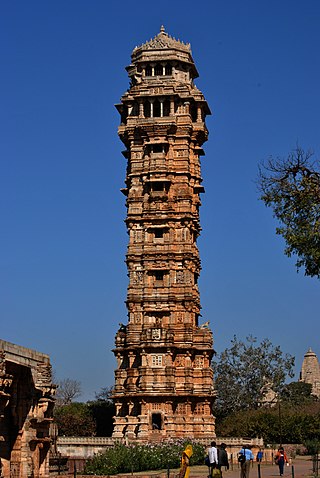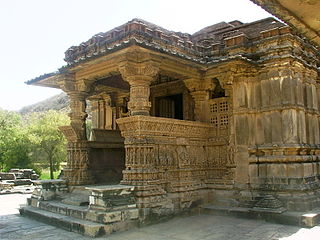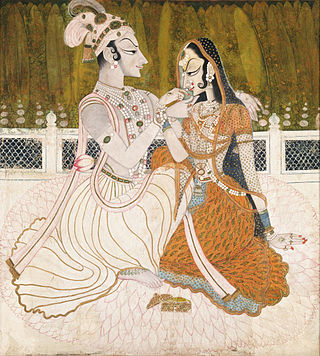
Chittorgarh is a major city in the state of Rajasthan in western India. It lies on the Berach River, a tributary of the Banas, and is the administrative headquarters of Chittorgarh District. It was a major stronghold of the Rajput State of Medapata. The city of Chittorgarh is located on the banks of river Gambhiri and Berach.
Maharana Hammir Singh (1302–1364), or Hammir, was a 14th-century ruler of Mewar in present-day Rajasthan, India. Hammir Singh, was a scion of the cadet branch Rana of the Guhila dynasty, who regained control of the region, re-established the dynasty after defeating the Tughlaq dynasty, and captured present-day Rajasthan from Muslim forces of Delhi and became the first of the 'Rana' branch to become the King of Mewar with title of Maharana. Hammir also became the progenitor of the Sisodia clan, a branch of the Guhila dynasty, to which every succeeding Maharana of Mewar has belonged.

Kumbhkaran Singh (1417–1468), popularly known as Maharana Kumbha, was the ruler of the Kingdom of Mewar. He belonged to the Sisodia clan of Rajputs. It was during his reign that Mewar became one of the most powerful political powers in northern India. He is considered to be the most powerful ruler of his time in India.

Ratnasimha was a ruler of the Kingdom of Mewar in present-day Rajasthan, India. He belonged to the Rawal branch of the Guhila dynasty, which ruled from the Chitrakuta fort. The last ruler of this branch, he was defeated by Alauddin Khalji during the Siege of Chittorgarh in 1303 CE.

Bagherwal is a digambar Jain community originally from Baghera, a princely state in Rajasthan. The town is situated in Ajmer district of Rajasthan near Kekri.

Rajasthan, a state in western India, has had a close historical connection with Jainism. Southwestern Rajasthan was the main centre for Śvetāmbara Jainism. Major Digambara centres are in the northern and eastern parts of Rajasthan. Central and Northern Rajasthan are the main centres for the Terapanth sect of Śvetāmbara Jainism.

Chittorgarh, also known as Chittod Fort, is one of the largest forts in India. It is a UNESCO World Heritage Site. The fort was the capital of Mewar and is located in the present-day city of Chittorgarh. It sprawls over a hill 180 m (590.6 ft) in height spread over an area of 280 ha above the plains of the valley drained by the Berach River. The fort covers 65 historic structures, which include four palaces, 19 large temples, 20 large water bodies, 4 memorials and a few victory towers.

A stambha is a pillar or a column employed in Indian architecture. A stambha sometimes bears inscriptions and religious emblems.

The Vijaya Stambha is a Rajput victory monument located within Chittor Fort in Chittorgarh, Rajasthan, India. The tower was constructed by the Hindu Rajput king Rana Kumbha of Mewar in 1448 CE to commemorate his victory over the army of Malwa led by Mahmud Khilji in the Battle of Sarangpur. The tower is dedicated to Hindu God Vishnu. Colonel James Todd considered it one of the finest examples of Hindu Rajput architecture & superior to Qutub Minar.
A manastambha is a pillar that is often constructed in front of Jain temples or large Jain statues. In North India, they are topped by four Tirthankara images.

The architecture of the Indian state of Rajasthan has usually been a regional variant of the style of Indian architecture prevailing in north India at the time. Rajasthan is especially notable for the forts and palaces of the many Rajput rulers, which are popular tourist attractions.

Balatkara Gana is an ancient Jain monastic order. It is a section of the Mula Sangh. It is often termed Balatkara Gana Sarasvati Gachchha. Until the beginning of the 20th century it was present in a number of places in India. However all its seats in North India became vacant in early 20th century. It survives only at Humbaj in Karnataka, which is its ancient seat.

Rajasthan is one of the most popular tourist destinations in India, for both domestic and international tourists. Rajasthan attracts tourists for its historical forts, palaces, art and culture with its slogan "Padharo Mhare Desh " The capital city, Jaipur, also known as Pink City, is a very popular tourist destination and is a part of the Golden Triangle. The Walled City of Jaipur is only the second Indian city to be recognized as a UNESCO World Heritage Site, after Ahmedabad.

The Mori Kingdom, also known as the Later Mauryas, was a kingdom that ruled over southwestern Rajasthan and northern Malwa in India. The kingdom was established in the 7th century, and reigned for a period of about 120 years. The Mori Rajputs controlled the Chittor Fort, and were a powerful military regime in this region before the rise of the Gurjara-Pratihara dynasty.

Apart from the architecture of Rajasthan, the most notable forms of the visual art of Rajasthan are architectural sculpture on Hindu and Jain temples in the medieval era, in painting illustrations to religious texts, beginning in the late medieval period, and post-Mughal miniature painting in the Early Modern period, where various different court schools developed, together known as Rajput painting. In both cases, Rajasthani art had many similarities to that of the neighbouring region of Gujarat, the two forming most of the region of "Western India", where artistic styles often developed together.

Hill Forts of Rajasthan are six forts, spread across Rajasthan state in northern India. They have been clustered as a series and designated as a UNESCO World Heritage Site in 2013. The hill forts series include—Chittor Fort at Chittorgarh, Kumbhalgarh Fort at Rajsamand, Ranthambore Fort at Sawai Madhopur, Gagron Fort at Jhalawar, Amer Fort at Jaipur and Jaisalmer Fort at Jaisalmer.
The history of human settlement in the west Indian state of Rajasthan dates back to about 5,000 years ago.
The Guhilas of Medapata colloquially known as Guhilas of Mewar were a Rajput dynasty that ruled the Kingdom of Mewar region in present-day Rajasthan state of India. The Guhila kings initially ruled as Gurjara-Pratihara feudatories between the end of 8th and 9th centuries and later were independent in period of the early 10th century and allied themselves with the Rashtrakutas. Their capitals included Nagahrada (Nagda) and Aghata (Ahar). For this reason, they are also known as the Nagda-Ahar branch of the Guhilas.

The siege of Chittorgarh occurred in 1303, when the Khalji ruler Alauddin Khalji captured and sacked the Chittor Fort, toppling the Guhila king Ratnasimha, after an eight-month-long siege. The conflict has been described in several legendary accounts, including the historical epic poem Padmavat, which claims that Alauddin's motive was to obtain Ratnasimha's beautiful wife Padmini; though this legend is considered historically inaccurate by most historians. Alauddin ordered the fort to be pelted with stones from his siege engines (munjaniqs). When the fort was stormed, Rajput women committed Jauhar while most of the warriors died defending the fort. The city of Chittor was completely sacked by Alauddin's army and several temples were desecrated.

The Samadhishvara Temple is a Hindu temple located in the Chittor Fort in Rajasthan, India. It is dedicated to Shiva, who is called "Samadhishvara", that is, "Lord of Samadhi". Epigraphic evidence suggests that the temple was constructed in the 11th century, and was further restored in the 13th and the 15th centuries.



















